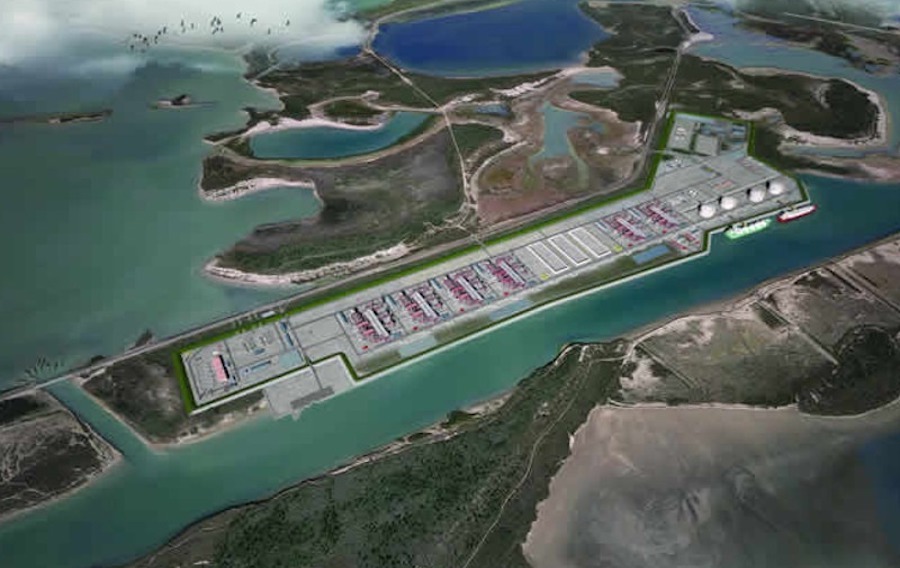In long-anticipated actions, the Federal Energy Regulatory Commission has approved two large liquefied natural gas export terminal projects on the Texas Gulf coast in Brownsville after re-evaluating their effect on climate change and on local communities as ordered by a 2021 federal appeals court ruling.
The approvals are for the estimated $11.5-billion Rio Grande LNG project being developed by NextDecade to produce 27 million metric tons per year at full five-train capacity, and the related $2.4 billion, 135-mile Rio Bravo pipeline, to be built by energy firm Enbridge.
Also approved on April 21 was the 4-million ton-per-year Texas LNG facility being developed by Glenfarne Group LLC. Its cost was not disclosed but Reuters estimated it at $3.2 billion to $4 billion.
In the new reviews mandated by project opponents' court challenge, FERC included a calculation of each facility's social cost of carbon emissions, although the agency noted the lack of accepted tools to determine whether the cost is significant or insignificant. “Accordingly, we have taken the required ‘hard look’ and have satisfied our obligations under [the National Environmental Policy Act],” FERC said.
Agency Chairman Willie Phillips said it "provided a full response to ... deficiencies identified by the court.”
But Commissioner Allison Clements dissented, saying she disagreed with FERC's explanation for not determining the emissions significance and for not preparing supplemental environmental impact statements for the projects. Also, the Sierra Club, a plaintiff in the 2019 legal challenge to FERC's original signoff of the Rio Grande project, said it would seek a rehearing of the latest approval, claiming the new review is still inadequate, with a new lawsuit possible.
Social Cost of Carbon
Commission staff said the social costs of carbon for Rio Grande LNG and the Rio Bravo pipeline are estimated at $18 billion and $2 billion, respectively. Rio Grande includes a carbon capture and storage project that would capture about 5 million metric tons of carbon a year, said FERC. The carbon cost for Texas LNG would be $2 billion.
FERC also broadened its evaluation—to a 31-mile radius from 2 miles—of the projects’ effects on environmental justice communities related to air pollution and other issues. Phillips called it “an unprecedented and bipartisan step to protect” nearby communities.
Project developers would also have to file a plan ensuring that overlapping construction and operation of the projects do not exceed federal air quality standards based on cumulative impacts, Phillips said, terming it a new agency mandate.
In a March 15 filing with the Securities and Exchange Commission, NextDecade said it would make a final investment decision on Rio Grande LNG by June 30. it also extended its EPC price agreements with Bechtel Energy to June 15 for first-phase construction, set to include the first three plant trains with about 17-million metric ton annual capacity. The agreement was extended after the developer missed a deadline to issue Bechtel a notice to proceed.
Final pricing will be determined when the investment decision is finalized. The first phase also includes two marine berths and two storage tanks.
Modularized Plant Design
Glenfarne Group said April 24 that it will make a final investment decision by the end of the year on its modularized LNG plant.
It signed an agreement in 2022 with joint venture partners Technip Energies USA and Samsung Engineering Co. to lead project delivery, including engineering, construction coordination, start-up and commissioning, Glenfarne said in a statement. Samsung owns a minority stake in the project.
“Texas LNG will be one of the greenest LNG facilities globally with its innovative ‘green by design’ strategy that uses renewable energy to power the entire liquefaction process,” said Vlad Bluzer, Glenfarne managing director and president of its LNG business, in a statement. The company also is exploring partnerships with other “like-minded companies” to ensure that upstream resources feeding the plant are responsibly produced, he said.
Texas LNG will use a patented Technip Energies’ design, which combines a compact modular design concept for mid-scale trains with standardized components and technology, the company said.
As many as 12 proposed LNG export plant projects in North America could finalize investment decisions this year, sector analysts say.






